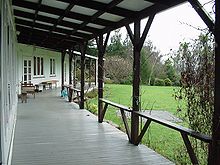Veranda

A veranda or verandah (from Hindi varanda, IPA: [vɐˈɾɐ̃dɐ]) is a roofed, open-air gallery or porch.[1][2] A veranda is often partly enclosed by a railing and frequently extends across the front and sides of the structure.[3]
Although the form "verandah" is correct and very common, some authorities prefer the version without an h (the Concise Oxford English Dictionary gives the h version as a variant,[4] and The Guardian Style Guide says "veranda not verandah").[5]
Architecture styles notable for verandas
Australia

The veranda has featured quite prominently in Australian vernacular architecture and first became widespread in colonial buildings during the 1850s. The Victorian Filigree architecture style is used by residential (particularly terraced houses in Australia and New Zealand) and commercial buildings (particularly hotels) across Australia and features decorative screens of wrought iron, cast iron "lace" or wood fretwork. The Queenslander is a style of residential construction in Queensland, Australia, which is adapted to subtropical climates and characterized by its large verandas, often in the filigree style.
United States
The Creole townhouse in New Orleans, Louisiana, is also noted for its prominent use of verandas. In fact, most houses constructed in the Southern United States before the advent of air conditioning were built with a covered front porch or veranda.
Spanish Colonial architecture (as well as the "Mission style" revivalist version that became popular in the Western United States in the early 1900s) commonly incorporates verandas, both on the exterior of buildings and, in cases of buildings with courtyards, along the interior walls of courtyards. In some cases, homes were constructed with every room opening into a courtyard veranda, rather than interior corridors or direct connections to other rooms.
Poland
In Poland, the word "weranda" is commonly used for the unheated roofed--and--fully enclosed porch (with a door)that is used to store things and perishable goods that do not need to be refrigerated (from home--made quark cheese to podpiwek) and leads to the heated part of the house.
See also
References
- ^ Poppeliers, John C. (1983). What Style is it?. New York: John Wiley & Sons. p. 106. ISBN 0-471-14434-7.
{{cite book}}: Cite has empty unknown parameter:|coauthors=(help) - ^ "Glossary of Anglo-Indian words - Veranda". University of Chicago. Retrieved 2015-07-08.
- ^ Ching, Francis D.K. (1995). A Visual Dictionary of Architecture. New York: John Wiley and Sons. p. 25. ISBN 0-471-28451-3.
- ^ http://www.askoxford.com/concise_oed/veranda?view=uk
- ^ http://www.guardian.co.uk/styleguide/v The Guardian Style Guide
